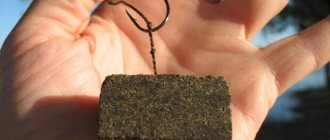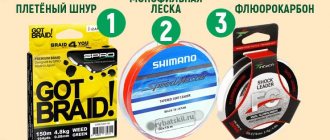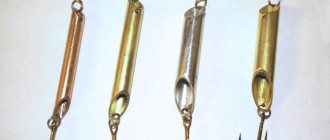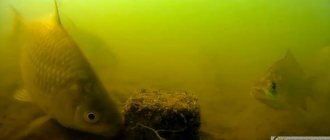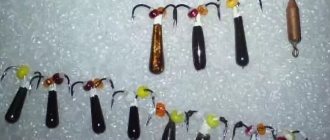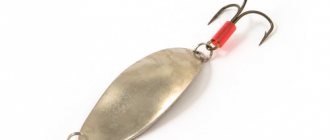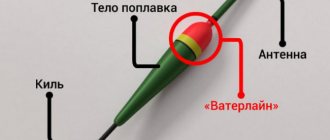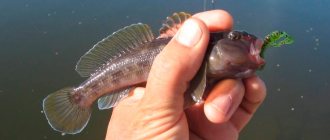Tackle for catching gobies
Classic equipment for catching gobies consists of the following components: main line with a diameter of 0.3-0.4 mm, 3-4 leashes (diameter 0.2-0.25 mm), a small sinker weighing about 50 g, and hooks numbered 7 or 8 with an extended fore-end. A sinker is tied to the end of the fishing line, below which a leash with a length of 15-20 cm is attached. Several more leashes are tied above the sinker, at a distance of 25-30 cm from each other.
Gobies love to pull hooks with bait under stones, which is why snags and subsequent breakages of gear often occur. For this reason, it is advisable to take several ready-made equipment with you, and be sure to have spare hooks, sinkers, and fishing line in your arsenal.
Tackle
What kind of gear can you use to catch a bull?
In fact, gobies can be caught both with the gear everyone is used to, and in less-than-usual ways. For example, it is not necessary to use expensive and thin gear for catching a goby, so it is better to choose a cheap fishing online store where you can always buy good fishing gear at a low price and not worry that the quality of fishing will deteriorate. Goby fishing
Fishing with a line from a boat
A very popular type of catching a bull from a boat using a regular fishing line wound around a finger. One hook of size No. 10-12 is tied to the end of the fishing line and a weight is attached (you select the weight of the sinker at your discretion). Wrap the other end of the fishing line around your finger and lower the bait to the bottom.
If the density of gobies at the fishing spot is high, then simply lower the bait to the bottom and wait literally half a minute. If there are not so many bulls, then you need to twitch the bait, knocking it on the bottom, making pauses.
To catch a goby in this way, use a fishing line with a cross-section of at least 0.4 mm so that the fishing line does not cut your hand. The goby is not a shy fish, so a fishing line with a cross-section of even 1 mm will not alert it. You can use a winter fishing rod for these purposes. The principle is the same, it’s just a little more comfortable to catch. You can use several hooks with different baits on the tackle at once.
This is how most anglers catch bullheads from a boat. A very convenient and effective type of goby fishing, which allows you to catch several dozen of this fish in a short time.
Spinning
To catch gobies with a spinning rod, an ultralight class spinning rod is used. For spinning goby fishing, it is best to use a microjig, and as bait:
- silicone worms;
- silicone fish size 1.5;
- tails from twisters and vibrotails cut in half.
The technique of placing bait when catching goby is quite specific. The fact is that the goby attacks the bait only when it is no further than 20 centimeters from it. Therefore, the wiring should consist of jerks of the bait of 15-20 cm, followed by a pause of about 10 seconds. This type of wiring is more reminiscent of dragging the bait along the bottom. But playing with bait should in no case be sluggish; the bull reacts better to sudden movement of the bait. Twitch the bait with your hand and pause, reel in the line a little and again give a small tug of the rod with your hand.
Catching a goby with a spinning rod allows you to catch a fairly large area in one cast, and if there are gobies in the way of the bait, there will definitely be bites if the bait is positioned correctly.
Zakidushka and donka
The bait is very easy to make, and the efficiency of catching a bull with such tackle is very high. To make the tackle, you will only need a sinker weighing about 50 grams, a 0.5 mm fishing line and 2-4 hooks No. 10-12. The hooks are attached to the main fishing line not directly, but on twenty-centimeter leashes. The distance between the hooks is also 20 cm.
After casting the bait, you need to tighten the fishing line and hang a guard on the fishing line. The guard can be a twig, a blade of grass or a bell. You throw a hook, a board or another object that you use as a reel, on which the fishing line is wound; the hook must be stuck into the shore, and a stick or straw, literally the very top edge, is placed on the fishing line that goes into the sea above the shore. The line is in a slightly slack state. When there is a bite, the line tightens and the guard falls. This is where it’s worth cutting.
If there are no bites within 5-10 minutes after casting, pull the tackle to the shore about a meter and wait for a bite again. Carry out such a pull until the bait falls into the bull's field of vision or the tackle is completely pulled ashore. If there are no bites, cast in another place. The same principle of fishing with a donkey, with the only difference that with a donkey you will not have a reel, but a rod.
Float rod
To fish with a float rod, it is not at all necessary to use a thick fishing line, since there is no danger of cutting your hand and it is also not necessary to make long power casts. It is better to place larger hooks so that the bull does not swallow small hooks deep into the mouth, causing difficulty in removing them.
It is optimal to use several hooks on one fishing rod at once, then, even if the bait is pulled from one hook, you can wait for a second bite on the second hook.
Microjig
Her movements should be jerky, with a very short movement distance, and with pauses between leaps. The goby does not chase long distances, it attacks in short swoops, instantly moving 5–15 cm. Moreover, attacks occur at the moment when the bait freezes or moves smoothly and slowly.
Any small rubber is suitable as bait for such fishing - edible small worms, and larger worms simply cut into two or three parts, twisters Paramax 1.5, fish of one and a half sizes... Offset hooks are selected in sizes No. 8 - 12 for your type of rubber, but if the number of empty bites is large, then you need to minimize both the size of the bait and the size of the hook. Sinkers can be very different - jigs, bullet-shaped, or split-shot pellets.
Goby baits
The goby belongs to the category of predatory fish, and therefore bites well on bait of animal origin. However, he does not refuse artificial baits, among which small silicone baits and wobblers are especially effective.
The goby's favorite baits are pieces of fish, worms, maggots, and mussel meat. When fishing, it is better to take several types of bait at once, since the goby can sometimes be quite capricious: it takes some baits perfectly, but ignores others.
Cool factor
When choosing a fishing location, you should first of all pay attention to such a factor as the weather.
- on cloudy days it is better to catch a bull in the shallows, not far from the shore;
- on hot days you should look for fish in deeper places;
- It’s better to ask locals about the most promising fishing spots so as not to waste time.
The easiest way to determine the concentration of fish is by the concentration of boats or fishermen in a certain place. The goby is a schooling fish. Therefore, feel free to take a place next to the other fishermen.
Goby fishing at sea
In the warm season, gobies swim in large numbers in the coastal zone without making noticeable migrations. These small predators often hide under stones or in grass, buried in the sand.
Weather can significantly affect the location of gobies and their activity. When the heat is too strong, as well as during storms, the fish move away from the coastline to depth.
In calm weather at normal temperatures, gobies often swim near the shore. In winter, as already mentioned, this fish also moves away from the coast.
In the Sea of Azov there are more than 10 species of gobies, among which the most common is the so-called round goby. Also found are the bull goby, bighead goby, sandpiper goby, sculpin goby and others. The largest individuals, as a rule, belong to the species of gobies.
In the Black Sea, goby is also excellently caught. It is worth looking for it, first of all, in places with a rocky bottom at a relatively shallow depth.
Fishing time
Goby fishing lasts all year round, both in summer and winter, but in winter the goby moves deeper into the sea, where the water temperature is more stable. After winter, the goby again comes closer to the shore and already in March it can be caught in the coastal zone.
The best period for catching bullheads is autumn. In autumn, the goby feeds with particular activity, preparing for winter, so fishermen's catches at this time of year are much larger. The best time to catch a goby is in the morning. It’s best to start catching a bull just before dawn, and when it starts to get light the bites of the bull will be very frequent and incredibly greedy. During the day, the goby's bite noticeably weakens and the goby's activity returns in the evening.
By the way, goby fishing is quite successful at night, so if you can’t sleep, you can easily take your gear and go fishing for goby at night. Fishing for gobies in the sea in the coastal zone lasts from April to November, after which the goby goes deeper, further into the sea.
Catching a bull with a microjig
Microjig fishing for bulls, which is attracted by active baits, can be very exciting and just as successful, while silicon baits with sluggish action often do not bring results.
However, it is also worth remembering that a predator may simply not be able to keep up with bait that is too fast.
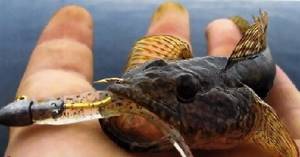
The movement of the microjig bait should be jerky. Pulling the line over short distances and periodically pausing will surely bring a catch. Gobies attack quickly, moving with lightning speed 10-15 cm from the original point. The bite occurs most often at moments when the bait freezes completely or moves very slowly.
For microjigging, small silicone baits of various shapes are used. For example, worms from edible rubber, which are placed on offset presses (No. 8-12), are very good. A variety of sinkers are also used (pellets, jigs, bullets).
For microjig fishing for gobies, you will need a light spinning rod with a test weight of up to 5 g and a length of no more than 2.3-2.4 m. You also need thin braid with a minimum windage and a breaking load of 4 lb. The leash is made from fluorocarbon fishing line, with a diameter of about 0.15-016 mm.
Bull tackle - how to make it yourself
The goby is a predatory fish that feeds on fry and mainly lives on the bottom in coastal areas. The goby is found both in salt water (Black Sea, Azov Sea) and in fresh water bodies. This diversity can be explained by the fact that there are a lot of goby species, and they have all adapted to life in different conditions.
The goby bites best in spring and summer. In autumn, the goby also actively bites, but only on animal baits. During the winter season, it goes deep into the depths, and it is much more difficult to catch it.
The bull's favorite habitats are snags, various burrows that he makes for himself on the sandy bottom, and areas of reservoirs with large stones.
Fishing tackle
To catch a bull, you can use the following gear:
- Float gear. A rod for catching a bull must have a length of at least two and a half meters. Its test should be selected depending on the baits used. For fishing with light baits, you should use a fishing rod with ten to twenty grams of dough. For fishing with more massive baits, you should use a rod with a dough of twenty to forty grams. It is recommended to use a fly rod with a parabolic action and a flexible tip so that you can comfortably fish out the caught bull. The float should be pear-shaped with a bright color and good stability for fishing on waves. As a reel, you can use a regular spinning reel made of high-quality material. The most suitable fishing line diameter (preferably monofilament) is considered to be 0.8 mm. Hooks must be numbered from 5 to 8.
- Snack tackle. The rod for it must be powerful in order to make long casts. The fishing line must be used with a diameter of at least 0.8 mm. The weight should be oval in shape and weigh between five and eight grams.
- Spinning tackle. To do this, you should use a high-quality spinning fishing rod with a dough of twenty to one hundred grams. Its length depends on the place of catch. If fishing takes place from a boat, then a two-meter rod will be enough. If from the shore, then it would be wiser to use a three-meter rod. A spinning reel should be inertia-free and work properly. Its spool must hold at least one hundred meters of fishing line. The main line should have a diameter of 0.5 mm, and the leader line should have a diameter of 0.3 mm. The most suitable leash length is ten centimeters. It is advisable to select a flattened shape for the weight to avoid frequent snagging. For fishing at shallow depths, the weight of the weight should be thirty grams. For longer casts, it is better to use weights weighing fifty grams. As for hooks, it is better to use strong stainless steel hooks with a silver color. They should have a long fore-end and a sharp sting. For spinning tackle, it is better to use hooks number 5 or 6.
- Bottom tackle. For it, you should select a special bottom rod with a length of four to five meters. The fishing line must be very strong and have a thickness of 0.6 mm. The best weight for a weight is considered to be from forty to fifty grams. Its shape should be triangular and flat.
In addition to the basic gear, you can use other gear to catch gobies: fly fishing and fishing rods. Let's look at them in more detail.
To catch a goby by fly fishing, you should use a one-handed fourth-class fishing rod with a length of two and a half to three meters. As a reel, you should use a special fly fishing reel that can maintain the balance of the entire tackle and accommodate the fishing line.
As a fishing line, you should use special cords for sea fishing, which have a very strong structure. For fly fishing, ten meters of such fishing line will be enough.
As for leashes, it is advisable to use nylon leashes with a diameter of 0.3 mm.
Fishing with a fishing rod requires the active participation of the fisherman in the process of catching gobies. To collect it you will need the following gear:
- winter fishing rod for trolling;
- monofilament with a diameter of 0.3 mm;
- hook No. 5;
- oscillating spinner.
Making tackle for a bull with your own hands
The most effective tackle that you can make yourself for catching a bull is an elastic band. It is used for bottom fishing, and in its structure it is very similar to an ordinary bait. Its important feature is that the rubber band can be thrown only once, after which it must be adjusted again.
To make this gear, you should prepare the following elements:
- Sharp hooks with a long shank.
- Line with a diameter of 0.2 mm to 0.3 mm for leashes.
- Line with a diameter of 0.5 mm to 0.6 mm for use as a main line.
- A strong elastic band with a length of three to five meters.
- Duct tape.
- Cambric.
- Reel (for winding fishing line).
The process of making a rubber band for catching a goby is as follows:
- First, you need to wrap a small layer of adhesive tape (ordinary electrical tape can be used) on the reel to make it easier to hook the hooks when transporting the finished gear. Also, the tape can be replaced with a small piece of foam rubber or foam, which are also very suitable for this purpose.
- Next you need to wind the fishing line on the reel (about forty meters). This will be enough for fishing from the coastal zone. If casting will be done from a boat, then more fishing line should be reeled in.
- Step back forty centimeters from the end of the fishing line and make five stoppers to secure leashes and hooks. You need to tie two knots to each stop one at a distance of one centimeter from each other. There can be many different types of knots, but it is best to make a double knot.
- After this, you should tighten all the knots and make another one nearby.
- At the tip of the fishing line, tie a loop with cambric. To do this, you need to stretch the fishing line into a cambric, the length of which must be at least four centimeters. After this, make a loop.
- Tie an elastic band to this loop. If you tie an elastic band directly to the fishing line, it will quickly come undone or fray, which will threaten rapid wear of the gear. The length of the elastic band used should be from three to five meters, but it is recommended to initially install a long elastic band so that during the fitting process it can be bandaged, trimmed and adjusted. You should know that if the length of the elastic is insufficient, the weight will be pulled up all the time, which will lead to the breakage of the tackle.
- Next you need to tie the fishing line to the weight.
- Then you should make leashes with hooks. To do this, you need to tie the hooks to the fishing line and make a loop.
- Place a cambric on the shank of the hook.
- Attach the leash along with the hooks between the stoppers on the fishing line. Pull the hooks into the loop and tighten near the main fishing line. After this, the equipment is ready.
How to catch more?
Over 7 years of active fishing, I have found dozens of ways to improve the bite. Here are the most effective ones:
- Bite activator. This pheromone additive attracts fish most strongly in cold and warm water. Discussion of the bite activator “Hungry Fish”.
- Increased gear sensitivity. Read the appropriate manuals for your specific type of gear.
- Pheromone-based lures.
The choice of gear depending on the fishing location and season
Depending on the place where the goby is caught, the following types of gear should be used:
- To catch gobies from a boat, it is very convenient to use a hook.
- For fishing from the coastal zone, it is better to use spinning gear.
- If fishing occurs at shallow depths, it is recommended to use a float rod.
- If the bottom of the reservoir is muddy, then you should fish with a spinning rod.
Depending on the season, the following gear should be used:
- During the winter season, it is recommended to use spinning tackle and a fishing rod, since this fish is at great depths at this time. You should also use heavy round sinkers and medium thickness fishing line.
- To catch gobies in the spring, you should use a float rod, since during this period this fish prefers to swim at shallow depths in the algae growth zone.
- For summer fishing, a hook or bottom tackle is perfect.
- When fishing for goby in the fall, it is better to use bottom tackle, since with the approach of cold weather, the goby sinks to the very bottom of reservoirs.
Blitz tips
- The best conditions for catching gobies are considered to be windy, cloudy weather. In hot weather, the goby hides in the depths, and its bite is practically absent.
- If after casting the tackle there is no bite for twenty-five minutes, then you should change the bait and the fishing location.
- If the goby is caught in heavily snagged places, then very strong fishing lines and hooks should be used that can withstand the hook.
prostokaras.com
Catching goby and rotan with ultralight spinning rod
Fishermen are becoming more and more conscious every year and are increasingly releasing the fish they catch. And often they now rush to reservoirs not for a couple of fresh steaks, but solely for the sake of pleasure, the climax of which is the brief moment of a bite.
It just so happens that there are no more monsters in the depths of rivers and lakes over the years. Even a couple of good pike perch in the city is a decent catch. This is probably a negative impact of progress. However, it was new technologies that made it possible to produce the lightest gear that opens up the vast world of ultralight.
Think about how many pike perch bites you will get during an evening fishing trip, say, on the Moscow River.
Two or three, well, at most a couple of dozen, and that’s if “The Master got to the exit.” You can splash water for hours and go home, grumbling about the weather or muddy water. With this situation, you look at catching the inhabitants of cans and tires in a completely different way.
With an ultralight spinning rod and microjig, the number of bites easily exceeds a dozen. And this is not a couple of hours of fishing, but ONE posting. Not enough adrenaline, you say? Not at all - a 300 gram perch on ultralight gear will seem like a catfish to you, and a pike will look like a Loch Ness monster. I’ll make a reservation right away: don’t even try to use a spinning rod with a test weight of more than 15 grams in ultralight - this will completely kill the positive emotions of fishing. The more delicate the tackle, the more pleasure. Within the city limits, it is the Moscow River that is most interesting for microjig. The only condition is the absence of strong wind. The variety of people who want to try the insect dancing at the bottom is intriguing. The catches consistently include roach, crucian carp, bream and, of course, perch of various sizes.
The round goby is found most often in the coastal zone. This lip slap chases the bait for a long time, jumping on it at every stop. You will have the best results when targeting bullheads with a silicone bait of about one and a half inches and a weight of about one gram.
I usually equip a silicone bait with a single hook, and the realization of violent bites is higher if the hook tip is rounded. Ordinary pellets clamped on a fishing line are convenient as a load. The main thing is not to overweight the bait: this will greatly increase the volume and change the wiring not for the better. It is better not to hang more than 3 g. A larger bait is also suitable, but the number of catches of round timber will be sharply reduced. It can be caught with a wobbler, but you don’t want to catch it with ultralight gear among the fittings and packages: expensive bait and thin fishing line are not the best combination. The diameter of the braid is important, and it is worth looking for the thinnest one. If you overdo it with thickness, even a slight breeze will not allow the bait to reach the bottom.
A retractable leash also works, but this equipment eats up the most interesting thing - the worst bite of a bull. But the drop shot is very promising. In such fishing, the most important thing is the choice of place. Probably the main sign that the place has been chosen incorrectly is the lack of bites on the first casts. Usually the most effective casts are downstream at an acute angle to the shore. Although in each specific case, options are possible - if a possible shelter is visible at the bottom, you need to closely fish for it from different sides.
When a bull is present at the “point”, it manifests itself instantly. And then there are two options: either on the first casts the largest specimens are caught, and on subsequent casts they become smaller and smaller; or persistent fishing along one trajectory attracts “jumpers” of different sizes, which are consistently and well caught. The goby does not like deep water and silted bottoms. Of course, it loves bottom debris, but it doesn’t disdain clean sand either. The round lizard can burrow into the sand, where it hides and tracks prey.
The wiring is classic stepped, only instead of two turns of the coil it turns out to be about half a turn. If the bull is in apathetic mood, you can try gentle dragging along the bottom. In such cases, a floating silicone bait comes to the rescue.
For example, Aiko Ribber Worm: it is both edible and has the necessary buoyancy. This is very cool, because with such a silicone bait, all sorts of pieces of foam in front of the bait or the need to pump it with air from a syringe are a thing of the past. Until recently, I caught bullheads with classic Japanese ultralight spinning rods, and everything was fine: both the sensors and the animation capabilities. Just recently I tried the “rockfish” Aiko Tirrel 221 cm up to 8 g. Of course, it is too powerful for catching gobies, but in Moscow there are not only gobies... As expected, the control of the wiring remained at approximately the same level. But the very first bite really delighted me: the fish did not feel the stick and actively chewed the bait.
A slight resistance from the tip of the spinning rod only encourages the bull. With a regular spinning rod, after biting a goby, there are two options: either hook it right away, or move the spinning rod forward, wait a little and hook it. With a soft tip, you can clearly see how the goby shakes the bait, which seems even more edible when it is lightly pulled out of its mouth. This allows for intelligent and very effective hooking. Thanks to the same tip, the dance of the bait can be performed with the most gentle swaying, more reminiscent of playing with a jig. The silicone bait seems to flutter from rock to rock and becomes an irresistibly attractive prey.
The spinning rod left a very pleasant impression: overall low weight (stated 98 grams), neat rings and assembly as a whole, a fairly bright design, but without frills. The only thing is that it would be possible to reduce the amount of varnish on the ring windings and the area of the windings themselves - the ring legs allow this. Tirrel, without straining, catapults the smallest weights even with pendulum casting thanks to the tip. And with normal casting it shows excellent range. When casting and retrieving, the spinning rod works with its entire form; when hooking, the middle of the second leg works, and only the tip is involved in retrieving. As I already said, the silicone bait should not be large.
Moreover, the presence or absence of a tail is indifferent to the bull. Of the factory baits, the smallest sizes of Relax and Manns work great, as well as edible “microbes” Curly Tail 1” from Aiko. More often, just a piece of larger bait is used. Cutting from salted Yamamoto, previously disfigured by pike teeth, works great. But the disadvantage of this rubber is still the same - even against the teeth of small fish, it does not resist for long. When the bite is good, the type of silicone is almost indifferent, but if the bull is capricious and hesitantly jigs, an edible silicone bait will definitely work better. I didn’t find much difference between different “tasty” rubbers, but its durability is important.
Everything is good with the survivability of Ike’s Ribber Worm 2”, besides, the silicone bait in the floating version does not fall into the stones and clings less. You can tear off 3-4 segments from this worm, resulting in a delicious insect with many legs. It was this silicone bait that the rudds of the Kaluga region liked. This capricious lady completely refused to take another silicone bait. Another goby that may covet a silicone puppet is the sculpin. The fish is incredibly beautiful with large wing fins. The larger the sculpin, the more beautiful it is. In the Moscow River it is less common than round timber, but you can catch a couple while fishing. His mouth is much larger, and his bite is fiercer. It doesn’t waste time on the silicone bait, but swallows it greedily. For this beast, silicone of about 2” and a weight of 3–4 grams are better suited. It is better to offer the owner of such a mouth a silicone bait on an offset hook. And do not forget that this handsome man is listed in the Red Book.
Now let's move from the river to the pond. Rotans and perches dominate here. I won’t even talk about perch - there’s a lot of information. But rotan turned out to be an incredibly interesting fish. When I caught it with a fishing rod, I got the deceptive impression that rotan is simple and indiscriminately attacks the worm and meat. The first bell rang when I was too lazy to dig for worms and planted a piece of silicone from Yamamoto instead of a worm. The rotan was very selectively caught on this particular piece, ignoring the meat and the worm. Last season, I decided to catch a pond monster on an ultralight spinning rod on purpose. The first rig was a symbiosis of a light jig and a drop shot. Even if the equipment is not very sporty, it showed that with rotan everything is not so simple...
On the first day, almost all of the rotan, as expected, was caught on the top hook. The very next day the situation changed radically: the main catch was microjig. And trying to catch it with a wobbler simply intrigued me. Imagine the picture: the two of us are fishing - I’m using a wobbler, my friend is using a drop-shot; I get bites on almost every retrieve and the catch is excellent, my friend’s is quiet... Half an hour passes, and it’s as if the rotan has been switched - all the catches are with the dropshot, but nothing with the wobbler... About two hours later the wobbler shoots again.
It’s generally very interesting with wobblers - rotan’s tastes change often: sometimes he likes minnows, sometimes he prefers shadik, and sometimes he runs after cranks. Rotan constantly changes its behavior and the horizon of the water where it feeds. It is also interesting that rotan is noticeably worse caught on “ideal” suspenders; those that slowly float or sink during a pause turn out to be much more attractive. This movement is where the grips occur. The presentation of the wobbler itself is very close to the night version of catching pike perch - a kind of mixture of stop & go and neat, leisurely twitching. Sometimes more intense convulsions of the bait are triggered, but only on condition that the retrieve speed remains low. The “rotary cauldron” is especially impressive - it’s like a perch cauldron, only very, very slowed down. Still, rotans are not very fast. I would like to try out the Walker, I think it will be interesting.
I remember when I was fishing with a fishing rod, rotan often grabbed the float, but pond ducks and swans are too keenly interested in this bait. The winged ones see the walker from afar and instantly move into the fishing zone, quickly chasing the bait all the way to the shore. Of the working lures, I would especially like to mention the Rigge 35 SS and its deep brother. And the choice is wide: Pirami 40 SP, Diving Beetle 40F from Skagit, Tiemco Sumary 38F, Crack Jack 48SP, Masu Masters 48S and even “chubbik”.
When fishing for rotan, it is better to put a thicker braided line - there are enough hooks. Sometimes the most effective wiring is done by scratching along the bottom. In this case, last year's leaves on the hooks are very annoying. Installing single rods on a wobbler almost completely solves it. The wobbler usually outperforms the drop-shot and jig in conditions of a good bite and a very bad bite, when a toothy firebrand barely pokes into the bait. Having correctly chosen the depth of the wobbler, you can easily comb the flat bottom, and use a deep pick to comb the sharp edge along the drop. The element of jig and drop shot are local shelters: piles, boxes, tires. And one more thing: the wobblers catch the most outstanding trophies.
The average size of rotan in the ponds where I fish is about 100 grams, but rotans often fly in over three hundred. This imposes certain conditions on the gear. No rockfish will do; here you need a powerful tool to cope with the bulldog grip of the Russian bass. Even after taking all reasonable measures, it happens that a large rotan hangs on the bait, squeezing it with its jaws, leaving the hook out of action.
I use a bass shorty Scylas 5'62” up to 10 g from Daiko: this tool allows you to use any equipment and clearly control every movement of the bait in such dangerous depths. This power is especially needed when drop-shot fishing close to cover. The equipment should not be heavy - 5 grams maximum. But the size of the offset hook should be maximum - rotan is not called that for nothing.
It’s better not to get too small with a silicone lure; all sorts of legs, tentacles and tails are welcome. The silicone rotan most likes Gary Yamamoto, which he loves more than fresh meat. However, this silicone does not last long. Silicone baits from Ecogear, Aiko and Yum have an optimal balance of edibility and durability. When biting actively, rotan will happily chew any silicone bait. It seemed to me that bright colors of silicone worked better, but for wobblers the best results were shown by models with mirror-shiny barrels.
Peter Moskalev

